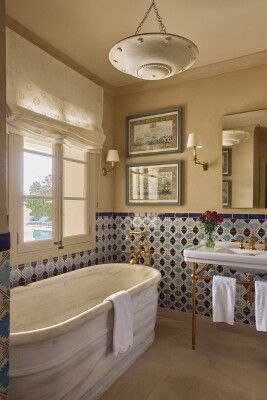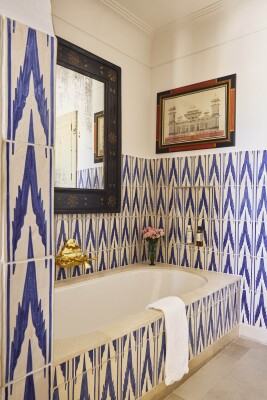A Star Designer’s Glorious Home on Mallorca
Photography by Ricardo Labougle

P edaling to fourth grade homeroom through Newport Beach, California, Michael Smith would stop his bike on a steep hill and find himself engulfed in fog and the heady smell of eucalyptus. He recently experienced the combination on Mallorca, the largest of Spain’s Balearic Islands. “The heat and fragrance and ocean—that’s what Mallorca is like too,” Smith says, conjuring the moment of freedom of being nine years old, at the helm of a bike. “It’s a paradisiacal version of California. It’s not the South of France.”

Now one of the world’s best-known decorators, with clients from a U.S. president to Hollywood power brokers, Smith has found part-time respite on Mallorca, where he and his partner, James Costos, recently took up residence. They’re in good company: Over the past decade, the Balearic real estate market, of which Mallorca comprises roughly 75%, has nearly tripled in sales volume, driven by an influx of northern Europeans, Scandinavians and Americans seeking a playground that is reliably sun-soaked throughout the year.
“We’ve been lucky enough to visit in every season. Each is beautiful and unique in its own way,” says Costos, who grew up in Lowell, Massachusetts. “But winter is something special—if you happen to catch a snowfall dusting the old villages and orange trees, it’s incredibly poetic.”
Smith and Costos didn’t need another place to live. They already had four: in LA and Rancho Mirage, California; New York; and Madrid. But the busier their lives got, the harder it became to resist another. “Our houses are these abstracted vessels for a life I don’t have,” says Smith, who has been known to equate his profession to that of an emergency room doctor. “Life is just permeable, and there’s no end.”
Maybe a few weeks on a windswept island in the Mediterranean would help?

Finca Xarbet, a courtyard house on 135 acres, popped onto their screens in summer 2019. When their offer—at asking price—was accepted, they weren’t surprised. The property had been on the market for years, and the owner had rented it out now and then, at one point to Costos and Smith. At the time, Costos, a former HBO exec, was serving as U.S. ambassador to Spain and Andorra under President Barack Obama. While commuting between LA and Madrid, Smith—fresh off a stint as the official interior designer for the Obama White House—took on a redecoration of the ambassadorial residence on Madrid’s Paseo de la Castellana. And in 2017, after Costos followed Obama out of office, Smith began transforming the first of two Madrid apartments into a setting where the couple could maintain the social life to which they’d become accustomed.

“Did I add a half-cup of the ‘making an embassy’ idea into the Madrid apartments?” asks Smith, whose new book, “Michael S. Smith: Classic by Design,” features these interiors. “Maybe. But hosting and entertaining are so joyful for me.”
With seven bedrooms and a hangar-like living room surrounding a pebble courtyard, the Mallorca house seems, above all, like a new opportunity to welcome a rotating cast of houseguests. Madrid-based architect Pablo Carvajal designed the single-story villa in 1993 for his sister, who took on the rock-strewn landscape as her personal cause, laboring for years to transform it into a series of fruit and olive orchards around a heavily cultivated inner sanctum. Smith has added mirror-image parterres of snowy shrub roses, an elegantly stepped water cascade, pea gravel paths for after-dinner strolls and a boxwood maze modeled on the 300-year-old example at England’s Hampton Court Palace, all ebbing into a native landscape that extends to the hem of the property.
Addressing the interiors, Smith admits, amounted to one big scroll through his mental inventory of the country’s most eye-catching rooms. “It’s not a small point that, until this past spring, you weren’t allowed to take photos inside Spanish historic houses” he says, with a drop of indignation. “If you think of William Randolph Hearst, who had such a profound impact on Spain because he would buy palaces, dismantle them and take them back to Hearst Castle—I did that mentally.”

It’s worth noting that cultural appropriation in the decorative arts has been going on as long as there has been another culture to appropriate. What Smith has done in Mallorca is closer to cultural reappropriation, to the extent that he has tracked down centuries-old Spanish workshops—some the original suppliers to the grand palaces that kindled his flame in the first place—and commissioned them anew.
In Seville, Smith worked with the decorative arts consultant Patricia Medina Abascal and a group of local artisans to reproduce examples of azulejo, the jewellike Hispano-Moresque tiles that distinguish the Casa de Pilatos, the city’s revered 16th-century palace, with layers of opulent pattern. On a tour of historical Mallorcan churches one weekend, Smith was surprised to find some of the same motifs on their pockmarked walls. (Collector Howard Marks, a longtime friend and client, has compared Smith’s visual recall to an IBM image bank with “infinite random-access memory.”)
“All these portraits say, ‘We dare you not to believe this is a historic house—we dare you.’”
A distinctive tile pattern appears in each of the villa’s bathrooms, all redesigned by Portuguese architect Alexandre Gamelas of A.G.C.S. Arquitectos to highlight the voluptuous glazing effects. More than any other element in Finca Xarbet, this vocabulary of tiles opens up a conversation with the island’s polyglot history.
Another trip to Seville introduced Smith to brothers Jerónimo and Manuel Seco-Velasco, goldsmiths whose archive of 17,000 metalwork patterns documents centuries of Iberian smithing traditions. Their luminous chalices, urns and crosses can be seen at the head of the city’s annual Holy Week processions. For the villa, the brothers crafted crystal chandeliers and elaborate bronze grates and grilles.
Unsurprisingly, Mallorcan sources are among Smith’s favorites. Artesanía Textil Bujosa in Santa Maria del Camí provided rustic, boldly patterned cottons, while Vidrios Gordiola, near the capital city of Palma, made handblown glassware. And ever present in Smith’s projects are contributions from his friends in the trade: Will Fisher of Jamb London, who replicated—down to centuries of deposited grime—a marble mantel Smith had admired, and Carolina Irving, who custom-colored her printed fabrics for bedroom walls.


Some of the splashiest pieces in the house come from the estate of John Nelson, an LA dealer who, until his death in 2021, excelled at prying mansion-scale antiques from collections across Europe. An early 18th-century baroque giltwood mirror over the living room fireplace is one of Smith’s favorites. At the opposite end of the spectrum are glass tumblers from Zara Home, repurposed as votive candle holders—he loves to trifle with high and low—and a rococo headboard he found in Madrid for $1,200 and retrofitted with a bed frame.
Picking up on Mallorca’s early allegiance to Rome, the designer had artisans paint an homage to the frescoes of Andrea Palladio’s Villa Malcontenta in the barrel-vaulted living room, substituting Mallorcan foliage and folklore themes for the Veneto’s. If this sounds vaguely Hearstian, remember that Smith cut his decorating teeth in Hollywood and has counted filmmakers George Lucas and Steven Spielberg as clients. “These houses are like movies,” he likes to say of his work. “But you get to live in them for longer than two hours.”
The cumulative effect of Finca Xarbet is both formidable and aesthetically fluid, says the furniture designer Hervé Van der Straeten, who recently spent a weekend there with his husband, fashion designer Bruno Frisoni. Van der Straeten admires the home’s sense of grandeur and fantasy. “It looks like an old Spanish family has been emptying out an old house,” he says, “and arrives with all their belongings in a clean and comfortable place.”

He may have in mind those high-functioning guest rooms, with their California King mattresses and wall-to-wall carpets. Smith sums up these choices as “bowing to the needs of my constituency. Not unlike [Virginia-born tastemaker] Nancy Lancaster going to England and taking American plumbing with her—we brought American beds with us to Mallorca!”
While Smith jokes that he is basically a “Mr. Nobody” in Spain—“I’m something like the biggest pop star in Ecuador”—the level of entertaining he and Costos have been doing here belies that claim. The estate is essentially an open-air theater for guests, and Smith is at the epicenter of every seating chart and menu plan. “One of Michael’s great talents is to work on the big things and also the details,” says Van der Straeten, whose own post-opening dinner parties à la maison are nothing to sneeze at. “Everything is relaxed and running well, but everything is precisely curated. That is not easy.”
As Smith curates, Costos squirrels himself away with “a portfolio of projects in finance, media and philanthropy, many of which intersect with Spain,” he says.

By the time the couple put a bow on the house, in the summer of 2023, they had already previewed Finca Xarbet to a sparkling array of visitors. They intend someday to share the wealth by making the house available for long-term rentals, in accordance with Spanish law. But Smith’s party-planning services (he calls entertaining “my version of needlework”) will not be included.
Still, he has gone ahead and supplied some well-dressed extras. The house bristles with historical portraits of elegantly costumed grandees amassed at auctions and elsewhere during the couple’s time in Spain. Smith says that he finds the paintings “evocative because they’re just so dramatic. They’re so imposing that they create an immediate sense of architecture.”
One of his favorites, which hangs in a pink bedroom, depicts Anne of Austria looking spectacularly dour in a nun’s habit. A Spanish-born princess (Philip III’s eldest daughter), Anne became Queen of France by marriage to Louis XIII—and, at age 37, the mother of Louis XIV. After ruling as her son’s regent for eight years, Anne retired in 1651 to a convent she had providentially established in her 20s as a sanctuary from royal life.


Smith chased the painting for years after eyeing it in the collection of British dealer John Hobbs, losing it at the last second in a 2002 auction of Hobbs’ collection, before landing it, finally, a few years ago. But where and how, he won’t divulge.
“She looks like an intense nun staring at you,” Smith says approvingly. “All these portraits say, ‘We dare you not to believe this is a historic house—we dare you.’”

As improvements at Finca Xarbet have taken hold, Smith and Costos have nurtured newly planted lemon and orange groves and trained jasmine over a pair of horn-shaped pergolas. In time, they hope to put the olive trees back into production and try their hands at making wine. Smith compares the house to a sundial; it tracks the day’s progress as light falls across the wild garigue and the mountains beyond. It hasn’t escaped him that, on the heels of the global pandemic’s peak, the value of inland acreage on Mallorca has risen more sharply than that of waterfront acreage: “The desired thing is space and land and privacy.”
For Smith, Mallorca will always be an echo of his Orange County boyhood. It is a cross-cultural hybrid of his old and new lives. “When you’re in fourth grade in California, you build a model of a Spanish mission out of sugar cubes—it’s sort of baked into what people think of as California,” he says. “It’s in the terrain, the architecture, the street names. I wanted to build our own version of that. I wanted to make a movie that I could be in.”

Cover image: A view of the house through the lemon trees.